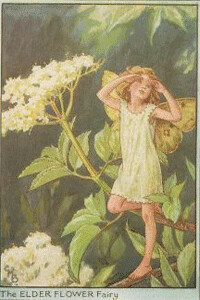
Now brimmed with nut and elder-flower so clean.
The men leaned on their rakes, about to begin,
But still. And all were silent. All was old,
This morning time, with a great age untold....’
Edward Thomas (1878-1917) from ‘Haymaking’
Royal Oak Day really marks the last of the national holidays for a couple of months. Life in the country is in full swing with shearing, haymaking and harvest. Local feasts of course still occur, but for the Feast and Festival lover, summer is actually quite a thin time. Forgive me then, if over the next couple of months I have to stretch my ingenuity a little further than usual, there'll still hopefully be lots to celebrate.
So there's no particular festival today (although Happy Birthday my friend Mags the ace nettle picker) but we need a post to fill a gap and the hedgerows are full of elder blossom. I love the succession of flowering hedge plants that mark the spring and early summer - blackthorn followed by may blossom followed by elder and all studded by the occasional crab apple, cherry, wild service tree and spindle. Elderflowers are the last shout of this frothy dance and the elder tree is heavy with mythology.

This is Cicely Mary Barker’s beautiful Elder Flower Fairy from 'Flower Fairies of the Woods and Trees' a book I knew by heart as a little girl. The northern European tradition is that every individual elder tree has a resident spirit, so chopping down a tree or damaging it, risks incurring the wrath of a suddenly homeless dryad. Apparently recited a poem might placate her. She must have been regarded as a powerful and beneficial sprite because it was common to plant an elder by the back door to keep witches away. The pungent smell of elder leaves and wood are also a strong fly repellent so the trees are associated with sites where animals were slaughtered.
The Anglo Saxons called elder ‘æld’ which actually means ‘fire’ and stems (no pun intended) from the practice of blowing down the tube of dried stem to encourage a fire to burn. Nicholas Culpeper says in his herbal published in 1653; ‘it is needless to write any description of this, since every boy that plays with a popgun will not mistake another tree instead.’ Nice to think of seventeenth century schoolboys blowing peas at each other through an elder twig.
Elder features strongly in mediaeval cookery when the young flowers were dried and kept to flavour sweet dishes and drinks. I can remember my Mother trying once to make elder flower wine, but the blossoms she picked were overblown and the resulting liquid smelled and looked like something our Siamese might have produced. Shakespeare refers to the smell in 'Cymbeline' - ‘that stinking elder‘
Both the sweet elder flowers and the sour elder fruit have numerous medicinal uses. I have used elderberries several times in hedgerow jelly, but actually since the cat pee episode I’ve never done anything with the blossom, although I do put elderflower cordial into gooseberry fool. So let’s to repeat that successful marriage here. Sambucade is a elderflower cheesecake which appears first in ‘The Forme of Curye’ a recipe book produced by Richard II’s cook.
Sambucade
8 digestive biscuits
50g unsalted butter
4 heads of not too open elderflowers ( picked over for insects and washed well)
1 carton mascarpone
3 tablespoons sugar
2 eggs
142ml pot soured cream
I prepared a 7" loose bottomed cake tin by greasing it with butter, then putting two strips of baking parchment on the bottom and up the sides at right angles to each other, then a piece of parchment on the base.
Make the biscuit base by crushing the digestives and then melting the butter, add the biscuits and press the mixture down in the bottom of the tin. Warm the sour cream and add the sugar - don't let it boil, when the sugar has dissolved add the elder flowers and leave for 30 minutes then strain. Put into a large bowl and add the mascarpone then the eggs, whisk until smooth, then pour over the base. Bake for an hour at 170c until set but still a bit soft in the middle. (I turned the oven down to 150c for the last 15 minutes.)
Turn off the oven but leave the cheesecake in the oven to cool to minimise cracking. Use the paper strips to help get it out of the tin and on the serving dish. This made a lovely soft cheesecake, I was doubtful whether you would be able to taste the elderflowers, but they were definitely there. I dropped some pearls of gooseberry puree round the dish to add a little sharpness.
‘.....When the Elder Tree’s in flower;
When each shady kind of place
By the stream and up the lane,
Shows its mass of creamy lace -
Summer’s really come again!’
From 'The Song of the Elder Fairy' Cicely Mary Barker (1895-1973)
3 comments:
What a lovely cheesecake, makes me wish we had elderflowers here. I used to love the elderflower cordial my in-laws used to serve when we visited them in Devon.
I'm a great lover of festivals also. Italy is our favorite place for feasts and sagre.
Lovely post Liz. Elderflowers are wonderful. I make elderflower cordial and elderberry rob whenever I can. Don't always manage to get to an elder tree at the right time though. Cheesecake sounds really good. I guess having and Elder outside your back door would help keep the flies out of the house and provide easy access to the medicine?
Wonderful. I love the delicate aspect of the cheesecake.
Imade elderflower champagne last year, but have not had the opporutnity to eat them yet. May have to have a go at a cake soon.
Post a Comment